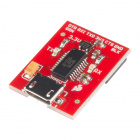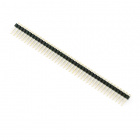WiFi IR Blaster Hookup Guide
This Tutorial is Retired!
This tutorial covers concepts or technologies that are no longer current. It's still here for you to read and enjoy, but may not be as useful as our newest tutorials.
View the updated tutorial: SparkFun WiFi IR Blaster Hookup Guide
Introduction

Experimental Products: SparkX products are rapidly produced to bring you the most cutting edge technology as it becomes available. These products are tested but come with no guarantees. Live technical support is not available for SparkX products.
With the advent of WiFi-connected "smart" devices, IR remotes are quickly becoming a thing of the past. Why sort through a coffee table-full of remotes when you probably have a much smarter, WiFi-connected device device sitting conveniently in your hand?
The WiFi IR Blaster is designed to connect all of those old, legacy IR-controlled devices to a WiFi network -- exposing them to a new method of control. Want to control your TV via a web-browser? Want to ask Alexa to mute your stereo? Want to schedule triggers to your IR-controlled LED strip? These are all applications that the WiFi IR Blaster is perfect for.
WiFi IR Blaster - ESP8266
SPX-15000The WiFi IR Blaster combines an ESP8266 -- a powerful WiFi/microcontroller SoC -- with IR emitters and receivers. With built-in WiFi support, the ESP8266 can be programmed to provide an interface between HTTP, MQTT, TCP, etc. and infrared-controlled devices.
This tutorial will explain how to assemble the WiFi IR Blaster and it will detail how to program the ESP8266 using the Arduino IDE. Once complete, you'll have a simple web server than can emit infrared signals at the click of a browser-page.
Required Materials
The WiFi IR Blaster includes the board, an infrared emitter and an infrared receiver. You'll need a handful of other tools and components to get it powered and programmed:
Infrared Remote Control
COM-14865The SparkFun Beefy 3 - FTDI Basic Breakout is primarily used to program the ESP8266, but it's also able to supply the 3.3V/300mA power required by the Blaster. Although you can use any 3.3V USB-to-serial converter, this is the one we recommend.
Headers -- either right-angle or straight are the recommended interface between your board, the programmer, a breadboard, perfboard, etc.
If you don't have an IR remote handy, the SparkFun IR RemoteControl is a useful tool for testing. It may even accidentally work with your TV!
In addition to those components, you'll need a soldering iron, solder, and general soldering accessories.
To add, you'll also need a local WiFi network that you can connect your ESP8266 up to. It also helps to have a second device -- smartphone or computer -- that's also connected to that network.
Suggested Reading
If you aren’t familiar with the following concepts, we recommend checking out these tutorials before continuing.




